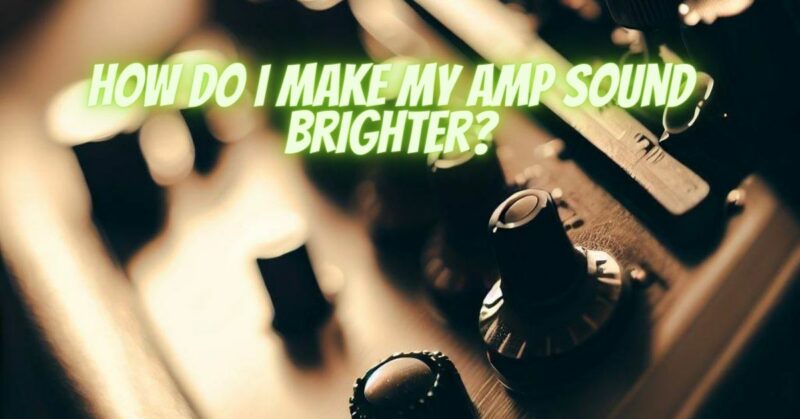Achieving the perfect guitar tone is an ongoing quest for many guitarists, and one common goal is to make their amp sound brighter. A brighter tone is characterized by enhanced clarity, crispness, and a pronounced high-frequency presence. Whether you’re playing a clean, jangly sound or looking to add sparkle to your distorted tones, this article will provide you with tips and techniques to help you achieve that brighter amp sound.
- Tweak Your Amp’s EQ Settings:
The most direct way to make your amp sound brighter is by adjusting the EQ settings. Most amplifiers come equipped with bass, mid, and treble controls. To make your tone brighter:
- Increase the treble: Raise the treble control to boost the higher frequencies, adding more sparkle to your sound.
- Decrease the bass: Reducing bass frequencies can prevent muddiness and allow the brighter frequencies to shine through.
- Experiment with the midrange: Adjusting the mids can affect the overall tonal balance. Try lowering the mids for a crisper sound or boosting them slightly to find the sweet spot.
- Use a Bright Switch (if available):
Some amplifiers come with a “bright” or “presence” switch. Engaging this switch can instantly add brightness and clarity to your tone. Experiment with it to see how it affects your amp’s sound.
- Change Your Guitar’s Tone Control:
Your guitar’s tone knob can significantly impact the brightness of your sound. Turn the tone knob clockwise to open up the high frequencies and achieve a brighter tone. You can also adjust it during your performance to fine-tune your sound.
- Choose the Right Pickups:
The type of pickups in your guitar plays a crucial role in your tone. Single-coil pickups are generally brighter than humbuckers. If your guitar has multiple pickups, consider switching to the bridge pickup, which often delivers a brighter sound compared to the neck pickup.
- Experiment with Different Strings:
The type and gauge of your guitar strings can influence your tone. Lighter gauge strings generally produce a brighter sound compared to heavier ones. Experiment with various string brands and materials to find the ones that best suit your desired brightness.
- Adjust Your Playing Technique:
Your playing technique can impact the perceived brightness of your guitar tone. If you pick closer to the bridge, you’ll accentuate the brighter harmonics and produce a crisper sound. Experiment with your picking position to find the right balance.
- Consider Using Bright Effects:
Pedals can be employed to shape your tone further. Consider using a dedicated EQ pedal to boost the high frequencies. Other effects like chorus, delay, and reverb can also add brightness and depth to your sound.
- Modify Your Amp (with Caution):
For advanced users, modifying your amplifier’s circuitry can achieve specific tonal goals. However, amp modifications should only be performed by experienced technicians to avoid damaging your equipment or voiding warranties.
- Acoustic Environment:
The room you’re playing in can affect how your amp’s brightness is perceived. Rooms with reflective surfaces can enhance the high frequencies, making your amp sound brighter. Experiment with room placement to find the sweet spot.
- Use Amp Simulations and Modeling:
If you’re using digital amp simulations or modeling, these often provide a wealth of tonal options. Explore the software’s EQ settings and tone-shaping features to achieve your desired brightness.
Making your amp sound brighter involves a combination of equipment adjustments, technique refinement, and experimentation. Remember that personal preferences vary, and what sounds bright to one person might not be the same for another. It’s essential to spend time fine-tuning your amp settings and exploring different approaches to find the brightness that suits your playing style and musical genre. By following these tips and maintaining an open-minded approach, you’ll be well on your way to achieving the crisp and clear guitar tones you desire.


